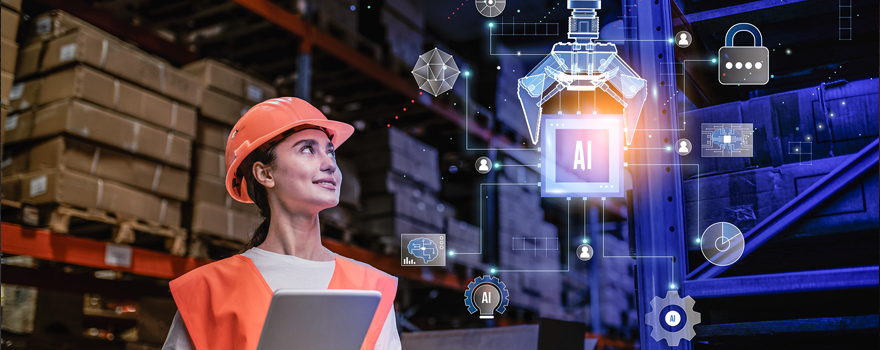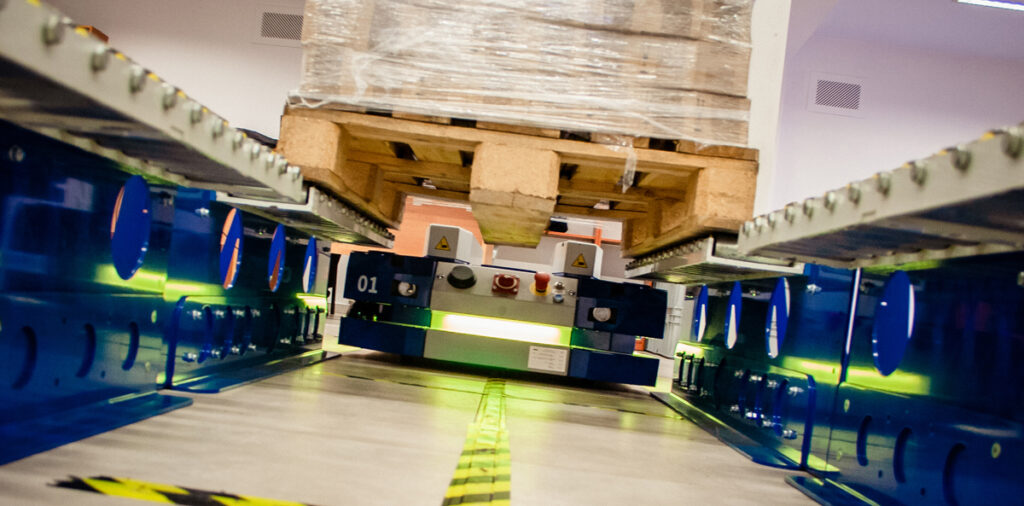
Modern technologies in the warehouse: mobile robots. Our expert talks about trends for today and tomorrow
In recent years Poland has witnessed and participated in a considerable progress in the field of advanced technologies used in warehouses. Companies use IT systems and automation technologies more and more frequently to streamline management and warehouse operations.
Within the framework of digitization warehouses use various inventory management systems such as WMS (Warehouse Management System), which make it possible to monitor and optimize the movement of goods in the warehouse. Warehouse Management Systems make it possible to track the location of goods, manage inventory, plan and monitor orders and optimize the warehouse layout.
Mobile robots as one element of warehouse automation
The automation of warehouse processes includes the application of such technologies as:
- AGV/AMR systems,
- automatic racks,
- sorters,
- pick-by-light
- pick-by-voice systems
which help to move goods and pick orders in a quicker and more accurate way. These technologies can speed up warehouse processes, increase efficiency and limit the risk of errors.

A lot of companies in Poland have invested in these technologies. The automation and digitization of warehouse processes are becoming more common because companies realize that they may bring plenty of benefits, such as increased efficiency, precision, and lower costs. However, it should be noted that not all warehouses in Poland are fully automated. Some smaller companies may have limited resources at their disposal and may not be able to fully implement advanced technologies. Nevertheless, the trend towards digitization and automation is gaining momentum and can be expected to grow in Polish warehouses in the future.
Which factors have the largest impact on the decision to use smart solutions in warehouses? Nature of processes, scale of operations, labor market issues, or other factors?
The nature of warehouse processes is of great significance because it depends on customer needs which have been changing relatively rapidly in recent years. An example is the e-commerce industry where the number of returns compared to the number of orders is growing. If a warehouse handles a large number of orders and operations, and the processes are complex, smart solutions can bring greater benefits.
The larger warehouse – the more reliable operation it needs
The scale of warehouse operations has influence on the decision about the application of smart solutions. Large warehouses, logistics centers and enterprises with an expanded warehouse infrastructure frequently invest in automation technologies because they may bring significant benefits in:
- terms of saving time and costs,
- optimizing warehouse spare
- handling more orders.
The situation on the labor market may be essential. In the event of a shortage of labor force, high employment costs or difficulties in the recruitment of employees, companies may decide on automation of certain processes in order to compensate for these problems.
Companies often decide on smart solutions to increase their efficiency and competitiveness. They want to adapt to the dynamic requirements of the market and ensure a competitive advantage.
What autonomous mobile robots need? Read about it!
Before making the decision to use smart solutions, companies carry out a cost analysis and evaluate the potential return on investment. Investments in automation technologies can be pricey, therefore companies try to assess whether the benefits outweigh the costs and whether the investment is worthwhile in the long run.
The larger the warehouse, the more reliable its operation needs to be
There are, of course, also other factors, such as technology availability, company strategy, legal regulations, and customer requirements, which can also affect the decision to apply smart solutions in warehouses. Each company makes a decision on the basis of its own needs, objectives, and possibilities.
Can we say that there is a specific trend of currently developed warehouse facilities? What does it concern?
One of the major trends in the development of warehouse facilities is the growing use of automation and robotization. Companies invest in the above-mentioned advanced warehouse systems, such as warehouse robots, AGVs and AMRs (Automated Guided Vehicles and Autonomous Mobile Robots) as well as sorting systems.
Ecology and artificial intelligence (AI). Increasing productivity, but also sustainable management
The green trend is more and more noticeable in the warehouse facilities being developed. A company with a responsible approach towards the environment relies on sustainable solutions such as energy-efficient lighting systems, photovoltaic installations, energy recovery and recycling. Moreover, green warehouses, which use low-impact materials and promote sustainability, are also being built more and more frequently.
The implementation of data analysis and artificial intelligence (AI) is another important trend. Warehouse facilities use advanced warehouse management systems and AI technologies to analyze data concerning inventory, predict demand, optimize warehouse layout, and make better business decisions. As a result, warehouses become more efficient, adaptive, and better suited to changing market conditions.
Companies invest in modern solutions
It is worth noting that these trends are not just specific to Poland but can be observed all over the world. Companies are investing in innovative solutions which make it possible to increase efficiency, sustainably manage warehouses and leverage the potential of data analysis. The objective of these trends is to improve the efficiency, precision, and sustainability of warehouse operations.
The value of the Polish e-commerce market was estimated at around PLN 90-110 billion in 2022. Is the e-commerce industry the main driver for the introduction of modern technologies in warehouses and will it continue to be one in the future?
It seems that the e-commerce industry is currently the main driver for the implementation of innovative technologies in warehouses and will continue to be one in the future. Its immense growth and development have created challenges for warehouses related to handling increased demand and product variety. This is affected by the aspect of product customization and the freedom to order and return products. E-commerce companies need innovative solutions to efficiently handle orders and provide high quality service. The above-mentioned technologies such as warehouse robots, sorting systems, data analysis and AI are crucial for increasing the efficiency, precision, and flexibility of e-commerce warehouses, enabling them to achieve a competitive advantage on the market.
Are all areas subject to technological innovation? Which warehouse area is most prone to development and why?
Not all warehouse areas are subject to an equal degree of the implementation of technological innovation. The areas that are most prone to development are those which require greater optimization, automation, and precision, such as order picking, sorting of goods and inventory management. The order picking area is particularly susceptible to innovation due to a high demand for fast and accurate order processing in e-commerce. Sorting areas are also susceptible to development to speed up and streamline the process of sorting and movement of goods. Inventory management areas are significant for optimal use of resources and cost minimization, which makes them more susceptible to the introduction of modern technologies.
In what direction is warehouse process management heading? What solutions can be expected in the next few years?
Warehouse process management is heading in the direction of increasing digitization, automation, and use of advanced technologies. It is expected that in the next few years we will observe further development of warehouse robots and mobile robots cooperating with people. Innovative solutions in the field of artificial intelligence and machine learning are also anticipated, which will make it possible to forecast demand, optimize inventory and plan routes in a more accurate manner. The increasing significance of drones in delivery can result in changes to warehouse processes, such as rapid order picking using drones. The use of Internet of Things (IoT) and RFID systems will make it possible to better track and manage goods in real time. The development of virtual and augmented reality technology can introduce innovations in training of warehouse workers and optimization of warehouse layout. The growing importance of e-commerce and customer requirements will result in the development of solutions related to order customization and fast delivery, such as automated packaging systems and delivery robots. Warehouses may also use technologies related to sustainable development, such as solar power or low carbon footprint warehouses. Eventually, the development of technology and innovation in the management of warehouse processes will focus on increasing efficiency, precision, flexibility, and sustainability.
Etisoft Smart Solutions mobile robots – a successful implementation
Please provide a brief description of the project your company has completed and what tangible benefits your client has achieved.
One of the most interesting projects carried out by Etisoft Smart Solutions is a system for automatic distribution of raw materials and finished goods between the production line and the warehouse using a fleet of AGVs.
The objective of the project was to eliminate manual transport on the whole production floor of a company which manufactures lighting for cars.
Successfully implemented in 2020, the system consists of a fleet of 6 vehicles and a fleet traffic management and mission ordering system – IntraFleet. The system transports the load on EUR1 pallets in three types of mission: transport of raw materials to 17 production lines, collection of finished goods and collection of unused raw material from these lines.
The system can achieve a maximum transport capacity of up to 40 pallets per hour, and almost 200,000 pallets have been transported since the implementation!
The use of mobile robotics for automated distribution of goods and warehouse operations meets the need for flexibility and scalability. The previous answers to questions have indicated a certain developing trend in automation and digitization of warehouses. We are glad that our company as well is not only heading in this direction, but also helping to develop it on a larger scale and present real benefits for businesses. Given the impact of global solutions on the labor market, as well as the increasing growth of companies and their warehousing needs, we have clarified and achieved the goal thanks to which the internal indicators of the company have improved, which have in turn translated into the quality, reliability, and speed of customer order completion.
Do you want to automate your warehouse? Ask for an offer!
The aforementioned text was prepared at the request of Logistyczny.com magazine, and the statements of our expert were partially used in the text featured in it: Trendy na dziś i jutro (logistyczny.com)
